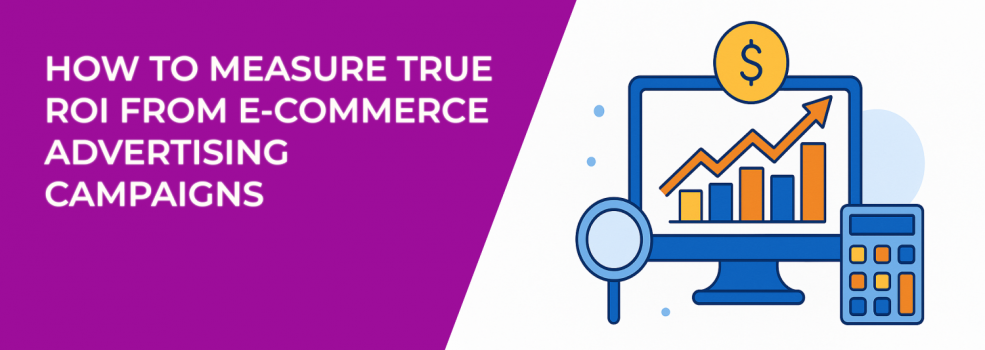E-commerce advertising can generate sales quickly, but measuring true ROI takes more than checking your ad platform’s dashboard. Many advertisers rely on Return on Ad Spend (ROAS) alone, but as explained in The ROAS Trap: Why High ROAS Isn’t Always Profitable, a campaign can look like a winner while quietly draining profit.
If you want sustainable growth, you need a full view of costs, customer value, and how ads interact across channels. Here’s a breakdown of how to measure ROI the right way.
Why ROI in E-Commerce Ads Is Harder to Pin Down
At first, ROI seems easy: you spend $1,000 on ads, generate $4,000 in revenue, and call it a 4x return. But this view ignores two things:
-
Costs beyond ad spend. Product expenses, shipping subsidies, payment fees, and discounts all eat into profit. For example, if 20% of orders are returned, your numbers collapse fast.
-
Attribution complexity. A customer’s journey often includes multiple steps. They may first see a Facebook ad, later search your brand on Google, and finally purchase after an email reminder. If you only credit the last touch, you’re undervaluing the ads that created awareness.
This is why advertisers often feel their Facebook ads are not converting, when in reality the problem is incomplete tracking.
Step 1: Account for All Costs
The formula is:
ROI = (Revenue – Costs) ÷ Costs × 100%
But “costs” must include everything, not just ad spend. Let’s break it down:
-
Product costs. If you sell a $100 shirt but it costs $40 to manufacture, your margin is already reduced by 40%. Ignoring this creates inflated ROI.
-
Shipping and fulfillment. Free shipping boosts conversion rates, but if it costs you $10 per package, it eats into every order. Imagine selling 500 items — that’s $5,000 out of profit.
-
Payment processor fees. Stripe or PayPal typically charge 2.9% + $0.30 per transaction. On $10,000 revenue, you lose almost $320 before counting other expenses.
-
Discounts and returns. A 15% discount across $20,000 in sales is $3,000 gone. Add a 10% return rate with free return shipping, and profit gets even slimmer.
Example: You spend $1,500 on ads and make $6,000 in sales. After deducting $2,400 in product costs, $600 shipping, $180 payment fees, and $400 in discounts, you’re left with $920 profit. Your true ROI is 61%, not the “300%” you see in the ad dashboard.
Step 2: Look Beyond Last-Click Attribution
Attribution tells you which ad gets credit for a conversion. Default settings often rely on last-click attribution, which gives credit to the final step. This misses the role of awareness ads.
Here are the main models:
-
First-click attribution. This gives credit to the first ad a customer engaged with. Example: a customer sees your Instagram ad, clicks, but doesn’t buy until later through a retargeting campaign. First-click attribution ensures that Instagram gets credit for sparking interest.
-
Last-click attribution. Credits the final channel. This is useful for knowing what closes sales but undervalues awareness channels. For example, if email brought the final click but Facebook created the initial visit, email gets all the credit under last-click.
-
Multi-touch attribution. Splits value across touchpoints. If a customer saw a TikTok ad, clicked a Google ad, and bought after a Facebook retargeting ad, all three channels get partial credit. This reflects reality more accurately.
You can refine these models using Facebook’s attribution tool, which helps you see how campaigns work together rather than in isolation.
Step 3: Measure Lifetime Value (CLV)
Looking only at the first order often misleads. Many e-commerce businesses make little on the first purchase but profit when customers reorder. That’s why Customer Lifetime Value (CLV) is essential.
How to measure CLV:
-
Repeat purchase rate. Track how many customers return. If 30% of customers reorder within six months, their value goes far beyond the initial purchase.
-
Average order value (AOV). Customers spending $80 per order bring more long-term revenue than those spending $40.
-
Customer acquisition cost (CAC). Compare the cost to acquire a customer with their lifetime spend. If CAC is $25 and lifetime spend is $200, ROI is strong.
Example: A skincare brand pays $20 to acquire a customer. The first order is $40, which looks like a slim margin. But data shows 40% reorder three times over the year, spending another $120. That makes the campaign highly profitable, even though first-order ROAS looked weak.
This is where blended metrics like Blended ROAS come in — they provide a clearer view of profitability across channels and timeframes.
Step 4: Use Cohort and Funnel Analysis
Cohort analysis groups customers by campaign or acquisition date. This helps you see long-term behavior differences.
-
Seasonal cohorts. Customers from a Black Friday deal may only buy once, while those from spring campaigns could return throughout the year.
-
Channel cohorts. Buyers from influencer campaigns may show higher repeat purchase rates than buyers from discount-heavy campaigns.
-
Offer cohorts. Customers acquired with steep discounts may churn faster than full-price buyers.
Combine this with funnel analysis: track how customers move from impression to click, add-to-cart, and purchase. If a campaign has high clicks but low add-to-cart rates, the problem may be with your landing page, not the ad.
For a structured view, read How to Analyze Campaign Performance Beyond ROAS: The Full Funnel View.
Step 5: Track Indirect Lift
Not every sale is directly linked to an ad click. Ads also build awareness, which leads to “halo” effects.
Ways to measure this:
-
Branded search traffic. Track whether searches for your brand increase during campaigns. A rise in searches often means ads are driving interest.
-
Direct traffic. Compare direct visits before, during, and after campaigns. A spike often means people saw your ads but didn’t click directly.
-
Organic conversions. If organic purchases increase during paid campaigns, ads may be fueling awareness that drives non-tracked sales.
Example: A shoe retailer runs a Facebook campaign. While many conversions are credited to Google Search, branded search queries rise by 40% during the campaign. That’s proof that Facebook ads drove awareness even if they weren’t credited with the final click.
Tools for Smarter ROI Tracking
Tracking all of this manually is difficult. Thankfully, tools help:
-
Google Analytics. Lets you compare attribution models and build multi-touch reports.
-
Meta Ads Manager. Gives breakdowns of performance, though it often over-attributes sales to Meta.
-
Third-party dashboards. Platforms like Triple Whale or Northbeam combine data from multiple channels and show blended ROI.
The key is clean data: use UTM tags for all ad links and make sure conversion events are firing properly. Without that, even the best tools won’t save you.
Final Word
True ROI isn’t just about revenue versus spend. It’s about measuring real profit after costs, accounting for attribution, understanding lifetime value, and seeing indirect effects.
Advertisers who stop at ROAS risk scaling campaigns that look good on paper but fail to create sustainable profit. Those who take the extra steps gain a clear picture of what drives growth and what drains budget.
The real question is: are your ads creating short-term sales, or long-term profitable customers?

